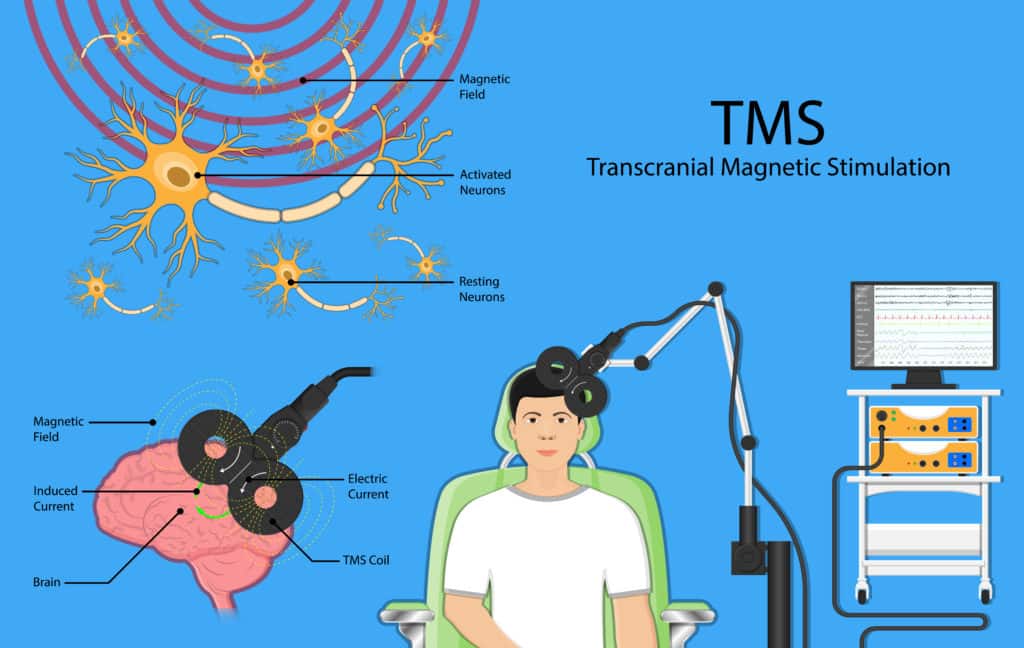How TMS Therapy Improves Anxiety

Anxiety disorders are prevalent in our world today. Statista reports that around 27% of American adults had anxiety disorder symptoms between April 27 and May 9, 2022. And the National Alliance of Mental Illness says over 40 million U.S adults have an anxiety disorder.
As the number of anxiety patients increases, scientific research to discover better ways to treat the condition intensifies. Already existing forms of treatment for anxiety include meditation, psychotherapy, and anxiety medication or natural supplements. While these traditional forms of treatment are effective, they don’t work for everyone.
TMS therapy or transcranial magnetic stimulation was developed as an alternative treatment for depression. This treatment is used when other treatment options haven’t been effective. TMS therapy also helps improve anxiety symptoms.
Table of Contents
What is TMS Therapy?
Transcranial magnetic stimulation is an FDA-approved, non-invasive brain stimulation therapy that uses magnetic charges to stimulate nerve cells. These pulses change cell activity, especially the areas controlling the mood. Also, it is a non-surgical procedure that leaves the patient with mild side effects that wear off over time.
If you or anyone you know has any anxiety disorder and has tried medications and psychotherapy without success, TMS may work for you. Several studies and reports (including this one) show that people who opt for TMS feel much better afterward. They have reduced symptoms of anxiety and fewer side effects compared to some other forms of anxiety disorder treatments.
Speaking about side effects, TMS may cause temporary side effects like lightheadedness, sleepiness, scalp pain, or tingling. If your side effects are intense, they will decrease after subsequent sessions. You can also speak to your doctor about this, and they may adjust your sessions.
How Does TMS Therapy Work?
TMS therapy aims to correct anomalies in the brain configuration of people with anxiety. Generally, such people have an unusual structure in their brain’s prefrontal cortex, which causes anxiety. In other words, this area of the brain does not function as it should, and the purpose of TMS is to activate it through the supply of magnetic current.
The mental health professional will begin the process by handling required tools, including earplugs, the magnetic coil, and the TMS machine. You will be asked to take off magnetic-sensitive objects, sit in a chair, and be comfortable.
If it’s your first session, the technician will measure your head. This is necessary to determine the best position to place the magnetic coil. When that’s complete, he will place the coil on the frontal area of your head.
You will know when the procedure begins when you hear a clicking sound – that’s the magnetic pulses being released. And you will feel the physical impact of the coil above your head. After your session, you can go about your daily activities without hassle.
How Much Does TMS Therapy Cost?
TMS Therapy is a relatively new anxiety and depression treatment and is generally more expensive than some medication and anxiety treatments. One session of TMS treatment costs around $250-$350, and the exact cost depends on the clinic and technician administering the treatment.
A complete TMS treatment takes several sessions and could last about 4-6 weeks. Supposing the cost for a session is $300 and you have to go five days a week for five weeks, the total cost will be $7,500. Again, this number could be higher or lower depending on other factors.
Fortunately, you don’t have to break the bank for a TMS therapy because insurance companies started covering costs a few years ago. With insurance, you will spend significantly less or nothing depending on the coverage and the insurance company.
There are some requirements to qualify for TMS therapy insurance cover, and it varies among insurance companies. This is the general criteria to keep in mind:
- Patients must have used 1-4 alternative antidepressant medications without success.
- Patients must have a history of psychotherapy conducted by licensed mental health professionals.
If you pass these requirements, you can benefit from insurance coverage from companies like Aetna, Cigna, and Anthem Blue Cross.
- -How to Learn relaxation techniques you can do anywhere.
- -Identify anxiety in yourself and others.
- -Learn how to better react to situations and set a firm foundation for dealing with stressful situations.
- Use Natural Supplements, Dietary, and Lifestyle changes to help you feel less anxious sooner.
- I am a Counselor in Training, so I share what I learn through my education and experience and the price will go up shortly--- However! You will get all of the free updates I make to the course at no additional charge to you! As I learn through research, my education, and personal experimentation of new supplement regimens I will share them with you!
How Long Does TMS Therapy Last?
Single sessions can last between 20 and 50 minutes, and the complete treatment course can be as long as six weeks. That is, five days a week for the entire duration. It does take some commitment on your part, but it may be worth it in the end. Also, you can go about your normal activities after each session, so you don’t need to go on leave or avoid the things you enjoy doing.
As for results, it generally takes at least five sessions before you will see improvements in anxiety symptoms. Although the treatment works, your attitude towards each session could play a role in determining the result. Have a positive mindset about the procedure, and go in each day with that conviction that you’re getting better. You will!
Is TMS Therapy Safe?
TMS therapy is a non-invasive approach to depression and anxiety treatments and is generally safe. However, this is based on the premise that the procedure is administered by a licensed professional. Also, both physician and patient observe best practices. Do not submit yourself for TMS therapy at the hands of a quack or unlicensed individual.
As with any treatment, you may experience side effects during and after all sessions. Some side effects include headaches (typical), painful scalp sensations and facial twitching (unpopular), and hearing problems due to the high-pitched sound of the TMS machine. You will be required to wear earplugs to reduce the impact of the sound.
The side effects generally fizzle away throughout the treatment. Besides, the doctor may adjust the coil positioning to reduce the painful effects of TMS therapy.
Closing Thoughts
TMS therapy specifically treats depression, but some studies show it helps with anxiety and other mental health conditions. If you have an anxiety disorder, first consider anxiety medications and psychotherapy. If those treatments do not work for you, TMS is a great alternative. Remember, you can drastically reduce the cost through insurance and only commit to treatment administered by a licensed physician.
Originally posted 2022-06-29 20:53:13.
Megan Santiago
Latest posts by Megan Santiago (see all)
- How to Find a Trauma Therapist in Tampa - September 30, 2024
- Get Your Child to Listen: A Clear-Cut Way To Feel Heard - March 10, 2024
- Help With Bills – How to Get Financial Assistance - March 10, 2024

